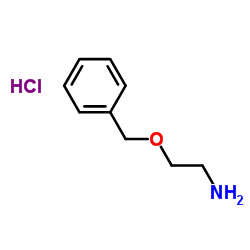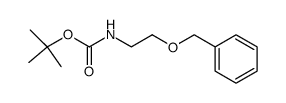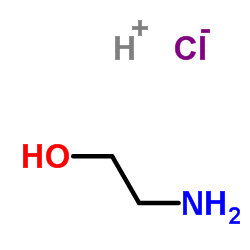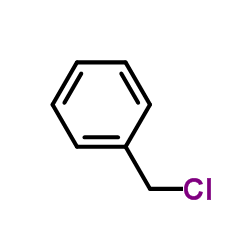2-phenylmethoxyethanamine,hydrochloride
Modify Date: 2024-01-02 09:22:30

2-phenylmethoxyethanamine,hydrochloride structure
|
Common Name | 2-phenylmethoxyethanamine,hydrochloride | ||
|---|---|---|---|---|
| CAS Number | 10578-75-3 | Molecular Weight | 187.667 | |
| Density | N/A | Boiling Point | 240.6ºC at 760mmHg | |
| Molecular Formula | C9H14ClNO | Melting Point | 142ºC | |
| MSDS | Chinese USA | Flash Point | 84.9ºC | |
| Name | 2-phenylmethoxyethanamine,hydrochloride |
|---|---|
| Synonym | More Synonyms |
| Boiling Point | 240.6ºC at 760mmHg |
|---|---|
| Melting Point | 142ºC |
| Molecular Formula | C9H14ClNO |
| Molecular Weight | 187.667 |
| Flash Point | 84.9ºC |
| Exact Mass | 187.076385 |
| PSA | 35.25000 |
| LogP | 2.66420 |
| Vapour Pressure | 0.0376mmHg at 25°C |
Synonym:none know Section 2 - COMPOSITION, INFORMATION ON INGREDIENTS
Risk Phrases: 21/22 36/37/38 Section 3 - HAZARDS IDENTIFICATION EMERGENCY OVERVIEW
Harmful in contact with skin and if swallowed. Irritating to eyes, respiratory system and skin. Potential Health Effects Eye: Causes eye irritation. Skin: Causes skin irritation. Harmful if absorbed through the skin. Ingestion: Harmful if swallowed. May cause irritation of the digestive tract. Inhalation: Causes respiratory tract irritation. Chronic: No information found. Section 4 - FIRST AID MEASURES Eyes: Flush eyes with plenty of water for at least 15 minutes, occasionally lifting the upper and lower eyelids. Get medical aid. Skin: Get medical aid. Flush skin with plenty of water for at least 15 minutes while removing contaminated clothing and shoes. Ingestion: Get medical aid. Do NOT induce vomiting. If conscious and alert, rinse mouth and drink 2-4 cupfuls of milk or water. Inhalation: Remove from exposure and move to fresh air immediately. If not breathing, give artificial respiration. If breathing is difficult, give oxygen. Get medical aid. Notes to Physician: Section 5 - FIRE FIGHTING MEASURES General Information: As in any fire, wear a self-contained breathing apparatus in pressure-demand, MSHA/NIOSH (approved or equivalent), and full protective gear. Extinguishing Media: Use water spray, dry chemical, carbon dioxide, or chemical foam. Section 6 - ACCIDENTAL RELEASE MEASURES General Information: Use proper personal protective equipment as indicated in Section 8. Spills/Leaks: Vacuum or sweep up material and place into a suitable disposal container. Avoid generating dusty conditions. Section 7 - HANDLING and STORAGE Handling: Use with adequate ventilation. Minimize dust generation and accumulation. Avoid breathing dust, vapor, mist, or gas. Avoid contact with skin and eyes. Storage: Store in a cool, dry place. Store in a tightly closed container. Section 8 - EXPOSURE CONTROLS, PERSONAL PROTECTION Engineering Controls: Facilities storing or utilizing this material should be equipped with an eyewash facility and a safety shower. Use adequate ventilation to keep airborne concentrations low. Exposure Limits CAS# 10578-75-3: Personal Protective Equipment Eyes: Wear appropriate protective eyeglasses or chemical safety goggles as described by OSHA's eye and face protection regulations in 29 CFR 1910.133 or European Standard EN166. Skin: Wear appropriate protective gloves to prevent skin exposure. Clothing: Wear appropriate protective clothing to prevent skin exposure. Respirators: Follow the OSHA respirator regulations found in 29 CFR 1910.134 or European Standard EN 149. Use a NIOSH/MSHA or European Standard EN 149 approved respirator if exposure limits are exceeded or if irritation or other symptoms are experienced. Section 9 - PHYSICAL AND CHEMICAL PROPERTIES Physical State: Solid Color: Off white Odor: Not available. pH: Not available. Vapor Pressure: Not available. Viscosity: Not available. Boiling Point: Not available. Freezing/Melting Point: 142 - 143 deg C Autoignition Temperature: Not available. Flash Point: Not available. Explosion Limits, lower: Not available. Explosion Limits, upper: Not available. Decomposition Temperature: Solubility in water: Specific Gravity/Density: Molecular Formula: C9H14ClNO Molecular Weight: 187.67 Section 10 - STABILITY AND REACTIVITY Chemical Stability: Stable under normal temperatures and pressures. Conditions to Avoid: Incompatible materials. Incompatibilities with Other Materials: Strong oxidizing agents, strong bases. Hazardous Decomposition Products: Hydrogen chloride, carbon monoxide, oxides of nitrogen, carbon dioxide. Hazardous Polymerization: Has not been reported Section 11 - TOXICOLOGICAL INFORMATION RTECS#: CAS# 10578-75-3 unlisted. LD50/LC50: Not available. Carcinogenicity: 2-(Benzyloxy)-1-ethanamine hydrochloride - Not listed by ACGIH, IARC, or NTP. Section 12 - ECOLOGICAL INFORMATION Section 13 - DISPOSAL CONSIDERATIONS Dispose of in a manner consistent with federal, state, and local regulations. Section 14 - TRANSPORT INFORMATION IATA Shipping Name: Not regulated. Hazard Class: UN Number: Packing Group: IMO Shipping Name: Not regulated. Hazard Class: UN Number: Packing Group: RID/ADR Shipping Name: Not regulated. Hazard Class: UN Number: Packing group: Section 15 - REGULATORY INFORMATION European/International Regulations European Labeling in Accordance with EC Directives Hazard Symbols: XN Risk Phrases: R 21/22 Harmful in contact with skin and if swallowed. R 36/37/38 Irritating to eyes, respiratory system and skin. Safety Phrases: S 22 Do not breathe dust. S 26 In case of contact with eyes, rinse immediately with plenty of water and seek medical advice. S 36/37/39 Wear suitable protective clothing, gloves and eye/face protection. WGK (Water Danger/Protection) CAS# 10578-75-3: No information available. Canada None of the chemicals in this product are listed on the DSL/NDSL list. CAS# 10578-75-3 is not listed on Canada's Ingredient Disclosure List. US FEDERAL TSCA CAS# 10578-75-3 is not listed on the TSCA inventory. It is for research and development use only. SECTION 16 - ADDITIONAL INFORMATION N/A |
| Hazard Codes | Xi: Irritant; |
|---|---|
| HS Code | 2922199090 |
|
~59% 
2-phenylmethoxy... CAS#:10578-75-3 |
| Literature: Faroux-Corlay, Barbara; Clary, Laurence; Gadras, Catherine; Hammache, Djilali; Greiner, Jacques; Santaella, Catherine; Aubertin, Anne-Marie; Vierling, Pierre; Fantini, Jacques Carbohydrate Research, 2000 , vol. 327, # 3 p. 223 - 260 |
|
~% 
2-phenylmethoxy... CAS#:10578-75-3 |
| Literature: US6265382 B1, ; US 6265382 B1 |
|
~% 
2-phenylmethoxy... CAS#:10578-75-3 |
| Literature: Carbohydrate Research, , vol. 327, # 3 p. 223 - 260 |
| Precursor 3 | |
|---|---|
| DownStream 0 | |
| HS Code | 2922199090 |
|---|---|
| Summary | 2922199090. other amino-alcohols, other than those containing more than one kind of oxygen function, their ethers and esters; salts thereof. VAT:17.0%. Tax rebate rate:13.0%. . MFN tariff:6.5%. General tariff:30.0% |
| 2-(phenylmethoxy)-ethylamine hydrochloride |
| 2-(benzyloxy)ethylamine HCl |
| 2-(benzyloxy)ethan-1-amine hydrochloride |
| 2-Aminoethyl benzyl ether hydrochloride |
| 2-Benzyloxy-aethylamin,Hydrochlorid |
| 2-benzyloxy-ethylamine,hydrochloride |
| 2-(phenylmethoxy)ethylamine,chloride |
| 2-phenylmethoxyethanamine Hydrochloride |
| [2-(Benzyloxy)ethyl]amine hydrochloride |
| 2-(Phenylmethoxy)ethylammonium chloride |
| 2-(3-CHLOROPHENYL)ETHYL CYCLOBUTYL KETONE |
| Z2O1R &&HCl |
| 2-(Benzyloxy)ethanamine hydrochloride (1:1) |
| 2-(Benzyloxy)-1-ethanamine hydrochloride |
| 2-(Benzyloxy)ethanamine hydrochloride |
| 2-(Phenylmethoxy)ethylamine hydrochloride |
| Ethanamine, 2-(phenylmethoxy)-, hydrochloride (1:1) |




